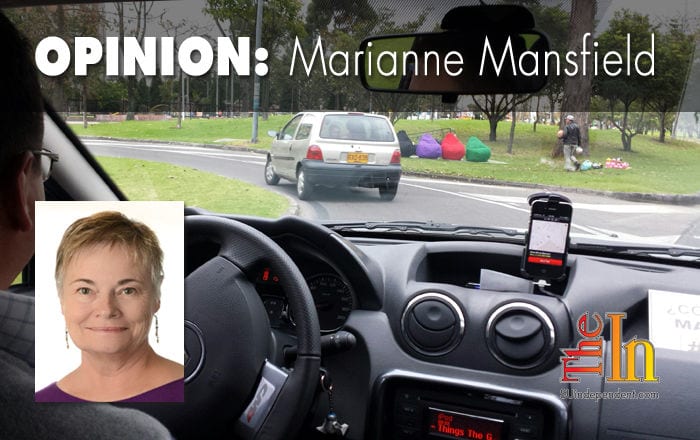
Ride hailing. Uber. Lyft. Are these familiar terms to you? If so, I’m going to guess that you travel frequently, often by plane, in and out of large cities with hub airports. Or you live in a large city. How did I do?
If, like me before I started researching this topic, those terms mean little to you, you might want to get familiar with them, even if you are a homebody. Ride hailing has the potential to change, and some would say “sully,” the world of car rides (or cabs or taxis, choose your term) for pay. In the process, the biggest loser may be the cab drivers who drive for traditional companies, mostly at minimum pay but for the insurance and other benefits.
First, ride hailing. Picture a person on a busy urban street standing near the curb, one arm raised, waving—sometimes frantically—at every yellow or green cab passing by until one swerves through traffic to pick up the person, the cabbie’s fare. We would say that person just hailed a cab. That is not ride hailing.
Now, picture another person, smart phone in hand, studying the screen just long enough to make a connection using an app he or she has downloaded from a website operated by Uber, Lyft, or any other of the ride-hailing start-ups. The connection will occur between the person needing a ride and an independent driver using his or her own car. Often times, a picture of the driver will appear with the promise to be at the door within 5-7 minutes of the deal being struck. If the rider agrees to the terms, the driver picks up the rider and delivers his fare to the venue of the rider’s choice. That is ride hailing. No standing on a curb waiting for a cab to appear.
Ride hailing services, most notably Uber, are exploding global phenomena fueled largely by the near-ubiquitous presence of the Internet in urban areas and interwoven with a fundamental restructuring of how business is done. Mix in labor laws that are mired in the last century and you get companies making money by the bulging fistfuls, often at the expense of the employees of more traditional transportation services.
In the two months since June, Uber has doubled its presence in India, which at this rate of expansion would bring that country in just behind China and ahead of Uber’s home country, the U.S., in terms of availability by the end of the calendar year. In China, Uber continues its unbridled growth despite the fact that the company is engaged in a vicious legal battle with WeChat (imagine Facebook with Chinese symbols and you have the basic concept). WeChat has scrubbed all mention of Uber from its platform after its parent company merged with another company that, go figure, has developed its own ride hailing apps.
Uber has gained the media spotlight, and often media wrath, not only for its meteoric growth trajectory but also for some questionable—at best—business practices.
Most recently, there has been growing concern about how Uber (and other companies as well) screens its driver-contractors. Uber is facing some of the fiercest challenges from an array of California officials who claim that the company does not adequately screen its rapidly expanding pool of tens of thousands of drivers. Uber responds that its screening practices are at least as effective as those that officials are pressuring them to adopt. Because Uber does not use fingerprinting in its screening, opponents argue that criminal data bases aren’t being accessed, thereby missing felons and those on sexual predator lists. Traditional taxi companies are taking note and touting their use of biometric data, including fingerprinting, for their drivers.
Then there is the question of a mega-company like Uber having access to such a rich database of personal information. Think about it. Anyone in an Uber car is vulnerable to being secretly tracked. Where are they going? How long did they stay? Were they alone or accompanied? Possession of such information wouldn’t be a problem if the company had a track record of handling it responsibly, but the opposite is the case. As recently as November of 2014, the company was defending itself against charges that company insiders were tracking and divulging the details of celebrities and journalists critical of Uber, who had taken a “Ride of Glory,” apparently having stayed the night and “scored” with a member of the opposite sex. Sleazy, right?
Then there is the much more salient issue to the rest of us: what does this do to the men and women who drive for traditional taxi companies? Since ride hailing drivers are not considered employees, they are not protected by labor laws, nor are they in a position to negotiate terms of employment that might include benefits like insurance and sick leave. The headline of a recent article in The Guardian captured the dilemma succinctly: “The Great Uber Fairness Fallacy: As a driver, how do you bargain with an app?”
In terms of fairness, both traditional drivers and Uber driver-contractors deserve a decent wage, the expectation of fair treatment, and access to some sort of due process for grievances. At this point, Uber driver-contractors have only the wage going in their favor.
Traditional drivers understand all too well that the presence of Uber threatens their livelihoods. Witness street-jamming protests staged by drivers against Uber cars in cities from Los Angeles to Paris. Violence has erupted more than once.
The questions surrounding the topic are puzzlers, at least to me. Given the trajectory of society toward near-total digital dependency, wasn’t ride hailing inevitable? Is it immoral for companies like Uber to play hardball as they grab larger and greater portions of the money the traveling public is willing to fork out? They provide a service that is as easy as a click or two on your phone. Waits of no more than five minutes. Quick and slick.
But there is the question of the traditional taxi driver: the man or woman who is working not only for the wage but also for the benefits for themselves and their families. And there is the less-than-stellar reputation of cabbies and their behavior in major cities. Even I, a seldom traveler, have had some experiences that have made my skin crawl and my heart threaten to leave the premises of my chest. Does that image doom the traditional service to the way of the dinosaurs?
And finally, there is just the sleaziness factor. The behavior of some Uber higher-ups is just plain ugly. Their business practices are repeatedly called into question, and it doesn’t seem to be getting any better. So, if it were a more likeable company, would using its service be justifiable?
How do you come down on it? Would you use Uber? Do you? I conducted a completely unscientific poll of two of my traveling friends. One said she would not use Uber if it were available to her because she stood “in solidarity with the cabbies.” The other said she has used the service and would continue to do so because her son and daughter-in-law, urban dwellers, thought the service was “fantastic.”
So there you have it. Stand shoulder-to-shoulder with the working stiff, or take advantage of the next neat slice of life the internet has made possible.
And why should this matter to you? For two reasons: the first is that Uber, Lyft and other ride-hailing services are everywhere, including Las Vegas and Salt Lake City. I would predict it will only be a matter of time before they reach us in St. George.
Then there is this: the presidential candidates have already started talking about Uber and Lyft in terms of the question of the sustainable wage.
Ride hailing isn’t going away anytime soon.




These services are necessary for some and a life saver for others. I have used both Uber and Lydt and never had problems so why not give them a chance. As we all know there are a considerable number of senior citizens in at least St George along with college students in both Cedar and St George who may not have cars and could benefit from both these services. I hope they do come to Southern Utah to offer their services.
Uber is HERE in St. George, sign up for the app!!!